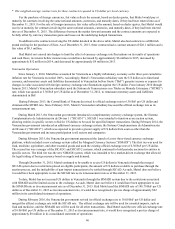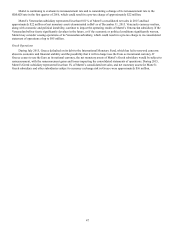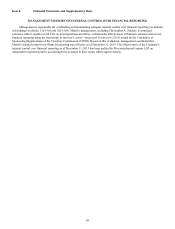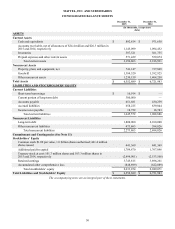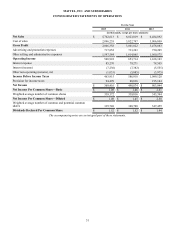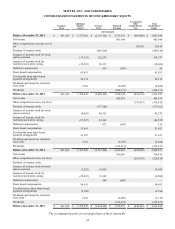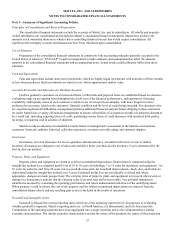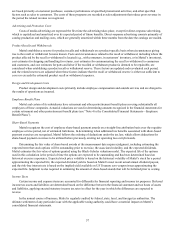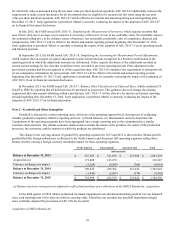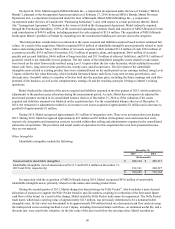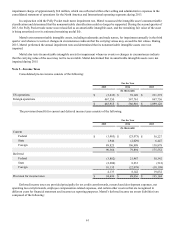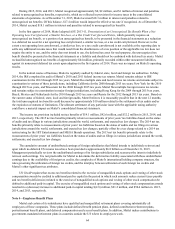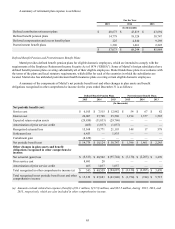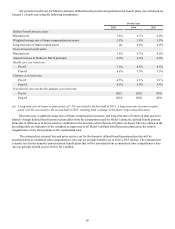Mattel 2015 Annual Report Download - page 60
Download and view the complete annual report
Please find page 60 of the 2015 Mattel annual report below. You can navigate through the pages in the report by either clicking on the pages listed below, or by using the keyword search tool below to find specific information within the annual report.56
processes, the customers, and the manner in which the products are distributed. Mattel tests its goodwill for impairment
annually in the third quarter and whenever events or changes in circumstances indicate that the carrying value of a reporting
unit may exceed its fair value.
Mattel tests its nonamortizable intangible assets, including trademarks and trade names, for impairment by comparing the
estimated fair values of the nonamortizable intangible assets with the carrying values. Mattel tests nonamortizable intangible
assets for impairment annually in the third quarter or whenever events or changes in circumstances indicate that the carrying
value may exceed its fair value.
Mattel also tests its amortizable intangible assets, which are primarily comprised of trademarks and trade names, for
impairment whenever events or changes in circumstances indicate that the carrying value of the asset may not be recovered.
Foreign Currency Translation Exposure
Mattel’s reporting currency is the US dollar. The translation of its net investments in subsidiaries with non-US dollar
functional currencies subjects Mattel to the impact of currency exchange rate fluctuations in its results of operations and
financial position. Assets and liabilities of subsidiaries with non-US dollar functional currencies are translated into US dollars
at year-end exchange rates. Income, expense, and cash flow items are translated at weighted average exchange rates prevailing
during the year. The resulting currency translation adjustments are recorded as a component of accumulated other
comprehensive loss within stockholders’ equity. Mattel’s primary currency translation exposures in 2015 were related to its net
investments in entities having functional currencies denominated in the Euro, Brazilian real, Mexican peso, and British pound
sterling.
Foreign Currency Transaction Exposure
Currency exchange rate fluctuations may impact Mattel’s results of operations and cash flows. Mattel’s currency
transaction exposures include gains and losses realized on unhedged inventory purchases and unhedged receivables and
payables balances that are denominated in a currency other than the applicable functional currency. Gains and losses on
unhedged inventory purchases and other transactions associated with operating activities are recorded in the components of
operating income in the consolidated statement of operations. Gains and losses on unhedged intercompany loans and advances
are recorded as a component of other non-operating (income) expense, net in the consolidated statement of operations in the
period in which the currency exchange rate changes. Inventory transactions denominated in the Euro, British pound sterling,
Mexican peso, Australian dollar, Canadian dollar, Brazilian real, Russian ruble, Malaysian ringgit, and Indonesian rupiah were
the primary transactions that caused foreign currency transaction exposure for Mattel in 2015.
Derivative Instruments
Mattel uses foreign currency forward exchange contracts as cash flow hedges primarily to hedge its purchases and sales
of inventory denominated in foreign currencies. At the inception of the contracts, Mattel designates these derivatives as cash
flow hedges and documents the relationship of the hedge to the underlying transaction. Hedge effectiveness is assessed at
inception and throughout the life of the hedge to ensure the hedge qualifies for hedge accounting. Changes in fair value
associated with hedge ineffectiveness, if any, are recorded in the results of operations. Changes in fair value of cash flow hedge
derivatives are deferred and recorded as part of accumulated other comprehensive loss in stockholders’ equity until the
underlying transaction affects earnings. In the event that an anticipated transaction is no longer likely to occur, Mattel
recognizes the change in fair value of the derivative in its results of operations in the period the determination is made.
Additionally, Mattel uses foreign currency forward exchange contracts to hedge intercompany loans and advances
denominated in foreign currencies. Due to the short-term nature of the contracts involved, Mattel does not use hedge
accounting for these contracts, and as such, changes in fair value are recorded in the period of change in the consolidated
statements of operations.
Revenue Recognition and Sales Adjustments
Revenue is recognized upon shipment or upon receipt of products by the customer, depending on the terms, provided
that: there are no uncertainties regarding customer acceptance; persuasive evidence of an agreement exists documenting the
specific terms of the transaction; the sales price is fixed or determinable; and collectibility is reasonably assured. Management
assesses the business environment, the customer’s financial condition, historical collection experience, accounts receivable
aging, and customer disputes to determine whether collectibility is reasonably assured. If collectibility is not considered
reasonably assured at the time of sale, Mattel does not recognize revenue until collection occurs. Value added taxes are
recorded on a net basis and are excluded from revenue. Mattel routinely enters into arrangements with its customers to provide
sales incentives, support customer promotions, and provide allowances for returns and defective merchandise. Such programs


